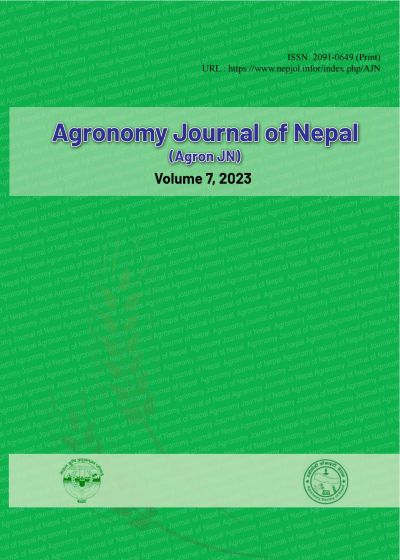Effect of Different Sowing Dates and Row Spacing on Growth and Yield of Faba Bean under Khumaltar Environment
DOI:
https://doi.org/10.3126/ajn.v7i1.62163Keywords:
sowing date, row spacing, faba bean, grain yieldAbstract
Faba bean (Vicia faba L.) is an annual minor grain legume locally known as Bakulla. An experiment on sowing dates and different row spacing was conducted at the National Agronomy Research Centre (NARC) Khumaltar from 2019/20 to 2021/22 to identify suitable sowing dates and row spacing. Three sowing dates (October 24, November 7, and November 21), row spacings (30 cm, 45 cm, and 60 cm), and plant-to-plant spacing of 10 cm were evaluated in a split plot with four replications. Plot size was maintained at 7.2 m2 (2 m x 3.6 m), the variety used was local, and the fertilizer dose applied was 20:40:20 N: P2O5:K2O kg ha-1. At physiological maturity, five plants per plot were sampled randomly for measurements of plant height, number of pods per plant, unfilled pods/plant, and 100 seed weight. Data on 50% flowering, days to 90% maturity, plant height, number of pods per plant, green pod yield, biological yield, and hundred seed weight were recorded. Combined analysis showed that sowing dates significantly influenced days to 50% flowering, final stand/m2, plant height, number of branches per plant, and number of pods per plant. The final stand/m2, plant height, straw dry matter, seed yield, and hundred seed weight were affected significantly by various row spacing. There was no significant interaction effect between sowing dates x row spacing, and all three factors (sowing dates x spacing x year) also had no significant interaction. The year they have significantly influenced all the parameters except 90% maturity and number of pods per plant. Sowing dates x year and spacing x year did not significantly influence all the parameters. Crop sown on October 24 produced the highest grain yield (1571 kg ha-1), followed by November 21 (1354 kg ha-1). Grain yields were significantly higher in 30 cm row spacing (1825 kg ha-1), mainly due to higher plant population per m2 than in 60 cm row spacing. It was concluded that the last week of October and 30 cm row spacing is suitable for faba bean production.
Downloads
Downloads
Published
How to Cite
Issue
Section
License
Copyright (c) 2023 Agronomy Society of Nepal (ASoN)

This work is licensed under a Creative Commons Attribution-NonCommercial 4.0 International License.
ASON permits for free use, distribution and reproduction in any medium if the original work is properly cited and not used for commercial purposes.




